Just about every RVer has a few power adapters, often referred to as “dogbones,” to make sure that they can connect to whatever power is available to them–this post will go over which power adapter types are safe to use, and which ones you might want to carry.
Circuit Protection
The job of a circuit breaker or fuse is to protect the downstream wiring from overloading and short circuits. Any wire configuration has a current rating, and a circuit breaker typically protects that wire.
Keeping that in mind, when we adapt an RV with a 50-amp plug (NEMA 14-50P) to either a 30-amp or 15-amp receptacle, the circuit breaker at the source will shut off power the wire’s limit is reached. At worst, under one of these configurations, we experience a nuisance pedestal breaker trip:
- 50-amp RV cord plugged into 30-amp, 20-amp, or 15-amp receptacle
- 30-amp RV cord plugged into 20-amp or 15-amp receptacle
For any of these configurations, you can find a UL-listed power adapter, and operate your RV safely.
But the other way doesn’t work. Let’s say you have something you want to power with a normal 15-amp plug. That includes a patio light, a heated hose, space heater or a string of flamingo awning lights. Now suppose you don’t have a 15-amp receptacle on the pedestal, or that you have something else plugged in.
Can you adapt down from a 50-amp or 30-amp receptacle on the pedestal to one for your 15-amp appliance? NO. If there was a problem with the appliance, or its cord, you could easily melt it before the breaker is overloaded enough to trip.
Note that in any of these situations, and even when plugging your RV directly into a pedestal, a receptacle in poor condition is still a hazard. A loose connection can easily generate enough heat to melt your plug or start a fire without tripping a breaker. If a plug goes in with little resistance, the receptacle probably needs replaced.
Power Adapters that are Safe to Use
All of these power adapters will have a smaller, lower amperage plug (male blades) on one end, and a larger/higher-amperage receptacle (female terminals). Look for UL-listed versions of these adapters, preferably with rigid grab handles.
50-amp RV plugged into 30-amp source
Power adapter has 50-amp female receptacle (NEMA 14-50R) and 30-amp male plug (NEMA TT-30P)

ClearMax RV Heavy Duty Electrical Dogbone Adapter with Handle, 30Amp Male to 50Amp Female - TT-30P to 14-50R,18 inches, Flexible 180 Degree Turn, Waterproof Camper Cord
(as of November 12, 2025 18:38 GMT -06:00 - More infoProduct prices and availability are accurate as of the date/time indicated and are subject to change. Any price and availability information displayed on [relevant Amazon Site(s), as applicable] at the time of purchase will apply to the purchase of this product.)Camco PowerGrip Camper/RV Dogbone Electrical Adapter | Features 30-Amp Male (NEMA TT-30P) and 50-Amp Female (NEMA 14-50R) Ends | Rated for 125V/3750W (55185)
$38.85 (as of November 12, 2025 18:38 GMT -06:00 - More infoProduct prices and availability are accurate as of the date/time indicated and are subject to change. Any price and availability information displayed on [relevant Amazon Site(s), as applicable] at the time of purchase will apply to the purchase of this product.)50-amp RV plugged into 15-amp source
Power adapter has 50-amp female receptacle (NEMA 14-50R) and 15-amp male plug (NEMA 5-15P)
Camco RV Dogbone Electrical Adapter with Innovative 180 Degree Bend Design and PowerGrip Handle - 15 Amp Male to 50 Amp Female, 12" (55168)
41% OffRV Electrical Power Adapter Cord-15A Male to 50A Female RV Power Cord 12inch 10/3 STW,NEMA 5-15P 15 Amp Plug to 14-50R 50 Amp Receptacle,Rated for 15A/125V,Not for EV Charger(CR1550)
$16.19 (as of November 12, 2025 18:38 GMT -06:00 - More infoProduct prices and availability are accurate as of the date/time indicated and are subject to change. Any price and availability information displayed on [relevant Amazon Site(s), as applicable] at the time of purchase will apply to the purchase of this product.)30-amp RV plugged into 15-amp source
Power adapter has 30-amp female receptacle (NEMA TT-30R) and 15-amp male plug (NEMA 5-15P)

Conntek 14101 15A to TT-30R RV Plug Adapter , Black
$5.62 (as of November 12, 2025 18:38 GMT -06:00 - More infoProduct prices and availability are accurate as of the date/time indicated and are subject to change. Any price and availability information displayed on [relevant Amazon Site(s), as applicable] at the time of purchase will apply to the purchase of this product.)Camco Camper/RV Dogbone Electrical Adapter - Features 15-Amp Male (NEMA 5-15P) & 30-Amp Female (NEMA TT-30R) - Rated for 125 Volts/1875 Watts & Crafted w/Copper 10/3-Gauge Wires (55165)
22% OffI’d advise avoiding this last type, just because of the mechanical strain it will create in most situations:

Camco 55325 15 AMP Male / 30 AMP Female 90 Degree Electrical Adapter, Yellow
16% OffDon’t use these Adapters
These adapters allow for the connection of a smaller cord to a larger source. The cord in this situation could be overloaded without a breaker tripping, which is a safety hazard. These devices cannot be UL-listed.
30-amp RV plugged into 50-amp source
Power adapter has 30-amp female receptacle (NEMA TT-30R) and 50-amp male plug (NEMA 14-50R) DO NOT USE!

Camco PowerGrip Dogbone RV Electrical Adapter - Features Heavy-Duty 50-Amp Male and 30-Amp Female Connections - Crafted of 100% Copper 10/3-Gauge Wires & Rated for 125V/3750W (55175)
15-amp RV/device plugged into 30-amp source
Power adapter has 15-amp female receptacle (NEMA 5-15R) and 30-amp male plug (NEMA TT-30R) DO NOT USE!

Camco PowerGrip 30AM/15AF Camper/RV Electrical Adapter | Features 30-Amp Male & 15-Amp Female Connections | Designed w/Non-Slip Grooves & Contoured Ends for Easy Removal | Rated for 125V/1875W (55233)
45% Off50-amp Receptacle plugged into 30-amp and 15/20-amp source
First of all, these adapters won’t work on any receptacle that’s protected by GFCI. Any 15 or 20-amp receptacle installed since the 1970s is required to be protected by GFCI. It either doesn’t work, or it does and you’re working off of electrical service that’s old enough to have concerns of its own.
Any combination of 15-amp and 30-amp receptacles plugged into 50-amp source
Power adapter shown has 15-amp female receptacle (NEMA 5-15R) and 30-amp female receptacle (NEMA TT-30R) that are split from a 50-amp (NEMA 14-50P) plug. The bigger issue is that you have a 15-amp or 30-amp receptacle protected by a 50-amp breaker. Also, if you look closely at the second one below, the handle for unplugging is a thin rubber strap that hooks on to the sides–that style isn’t very easy to unplug, and they’ll break, usually long before the plug itself needs retired. DO NOT USE!
Parkworld 885545 Combiner, RV Splitter V Adapter Cord 5-15P & TT-30P Male to 14-50R Female
$29.99 (as of November 12, 2025 18:37 GMT -06:00 - More infoProduct prices and availability are accurate as of the date/time indicated and are subject to change. Any price and availability information displayed on [relevant Amazon Site(s), as applicable] at the time of purchase will apply to the purchase of this product.)Parkworld 885200 Splitter, RV 50A to 30A & 15A V Adapter Cord 14-50P Male to TT-30R & 5-15R Female
$39.99 (as of November 12, 2025 18:37 GMT -06:00 - More infoProduct prices and availability are accurate as of the date/time indicated and are subject to change. Any price and availability information displayed on [relevant Amazon Site(s), as applicable] at the time of purchase will apply to the purchase of this product.)Differences between RV Plugs and Common Household Plugs
Perhaps the most confused RV plug is the 30-amp TT-30, which looks very similar to the common 3-wire clothes dryer plug (10-30) which was installed in homes built prior to 1994. The two plugs are physically different in the center pin, but more importantly, they’re wired differently. The dryer plug supplies 240V, with a ground-neutral bond. This bonding means that the ground–which is designed to be a safety feature–is also current-carrying, which negates that function under certain conditions. The National Electric Code prohibited that practice in new home construction beginning in 1994, and a 4-wire plug has been used since then.
If having an electrician install a 30-amp service for an RV, make sure that it’s a TT-30 configuration, and that it’s properly wired to supply 120V with separate ground and neutral.
Which brings us to another plug, the RV 50-amp plug, which is a NEMA 14-50. This plug is commonly found on electric ranges, and is similar to–but different from–the typical dryer, which uses a NEMA 14-30. The 30-amp dryer plug has an L-shaped neutral, whereas the 50-amp RV plug has a straight blade. While not common, it would be safe to plug a 50-amp RV into a 30-amp 4-wire dryer receptacle, but not a 30-amp RV into a 50-amp range receptacle.
Is there a way to plug a 30-amp RV into a 50-amp pedestal?
Yes, but it’s not a product that you can just go out and buy. Do do it safely, you’d need a short cord sized for 50-amp service into a subpanel with a 30-amp breaker. If enough of you are interested, we might build one up to show the process.
Ok. Enough already! I’m a new RVer–what power adapter should I carry with me?
Each of these adapters have a rigid, molded grab handle, and have the plug at the proper orientation so that the cord and plug aren’t strained when hanging. Identify which type of RV you have based on the plug images below.
50-amp RV
If you have a 50-amp RV, it should have a plug like this:
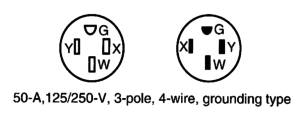
In that case, you can plug in anywhere (50-amp, 30-amp, and 15-amp receptacles) with these two adapters:


Camco PowerGrip Camper/RV Dogbone Electrical Adapter | Features 30-Amp Male (NEMA TT-30P) and 50-Amp Female (NEMA 14-50R) Ends | Rated for 125V/3750W (55185)
$38.85 (as of November 12, 2025 18:37 GMT -06:00 - More infoProduct prices and availability are accurate as of the date/time indicated and are subject to change. Any price and availability information displayed on [relevant Amazon Site(s), as applicable] at the time of purchase will apply to the purchase of this product.)Camco RV Dogbone Electrical Adapter with Innovative 180 Degree Bend Design and PowerGrip Handle - 15 Amp Male to 50 Amp Female, 12" (55168)
41% Off30-amp RV
If you have a 30-amp RV, your plug will look like this:
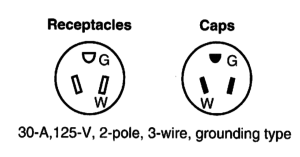
And you’d need two different power adapters. First, the more common that allows you to plug into a 15-amp receptacle:

Camco Camper/RV Dogbone Electrical Adapter - Features 15-Amp Male (NEMA 5-15P) & 30-Amp Female (NEMA TT-30R) - Rated for 125 Volts/1875 Watts & Crafted w/Copper 10/3-Gauge Wires (55165)
22% OffThe second is less common, and more expensive. It contains a 20-amp breaker to protect your shore power cord when plugging in to a 50-amp pedestal, and can be used with the adapter above you get you 20-amp service, properly protected. It’s the only solution I’m aware of short of assembling your own breaker box at the pedestal for this combination.
https://www.lowes.com/pd/AC-WORKS/5013313793



















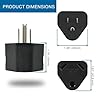
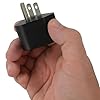













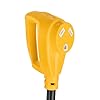
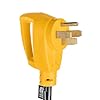

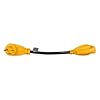

















Re: 30-amp RV plugged into 50-amp source
Power adapter has 30-amp female receptacle (NEMA TT-30R) and 50-amp male plug (NEMA 14-50R) DO NOT USE!
Please explain why this is not good to use. Why do they make these adaptors if they are not safe? My friends use this all the time!
The reason this isn’t a safe configuration is that a 30-amp RV cord isn’t rated to handle 50 amps. The breaker will be a 50-amp breaker and won’t be able to protect the cord from an overload. The RV should have a 30-amp main breaker which would still prevent an overload, but only if the overload is downstream of that breaker.
If I have a 50 amp service which one is safe to plug my 30 RV into?
Special dogbone??
To do it right, what you really need is a 50-amp (male) plug feeding a small breaker box with a single-pole 30-amp breaker in it along with a 30-amp (female) receptacle. The reason for the extra breaker is that your RV’s 30-amp shore power cord is going to be smaller wiring than a 50-amp cord–you want to protect that cord, and the 30-amp outlet, from being overloaded.